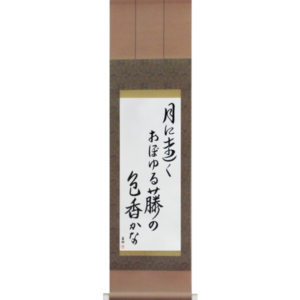H3026 Haiku by Buson – To white plum blossoms …
by Master Japanese Calligrapher Eri Takase
To white plum blossoms.
Each night just dawning.
Evermore. [1]
|
shiraume ni akuru yo bakari to nari ni keri |
白梅に 明る夜ばかりと なりにけり |
| buson | 蕪村 |
This was the final of three poems that Buson wrote on his death bed. There are (at least) two schools of thought on how to translate this beautiful poem. One is to translate exactly what the poem says and the other is to translate what the poem means – of course, the latter is subject to far more interpretation.
Of the first school of thought, Kai Hasegawa gives the most direct translation:
Kai Hasegawa suggests the translation:
With white plum blossoms
the dawn is about
to break. [2]
Kai Hasegawa writes:
The poem describes how he was waiting impatiently for spring to come, knowing his end was approaching. When that day broke, Buson would no longer be able to stand beside the white plum blossoms described in the poem. [2]
The other school of thought is that this is Buson’s vision of what is to come: That this life has been winter and, in death, every night will dawn to a world of white plum blossoms. Haruo Shirane is also of this school and writes:
Plum blossoms, which are admired for their light fragrance, appear at the beginning of spring when the weather is still cold. The darkness of the cold night turns into the dim light of dawn amid the faint whiteness of the plum blossoms, which embody Buson’s spirit as it disappears into the light of dawn. This poem is also about the transition from winter to spring. [3]
Haruo Shirane suggests the translation:
Amid white plum blossoms
night turns to dawn –
the time has come. [3]
Saito and Nelson seem to share this view:
Saito and Nelson suggest the translation:
With white apricot blossoms
Each day dawns –
That time has come. [4]
Buson died not seeing the dawn and not seeing again the plum blossoms that he envisioned in his poem. He died on the last day of winter and the plum blossoms outside, the harbinger of spring, perhaps spoke to him of what was to come. In this sense, T. Imoto focuses his commentary on the image of a single white plum blossom representing the absolute first light of dawn that grows and grows until the entire world is filled. And he uses this as a metaphor for the afterlife that Buson envisions before him. [5]
Whether all Buson was saying was that it would be enough for him to see the plum blossoms just one more time in the morning or that he is speculating on the afterlife … forever in our hearts will be Buson’s image of night breaking into dawn, winter into spring … and the promised hope of plum blossoms.
Makoto Ueda suggest the translation:
From now on
Every night will dawn
With white plum-blossoms. [6]
This is for Victoria.
Calligraphy Notes:
1) 明る (akuru) today is more commonly written 明くる (akuru).
2) For purely artistic reasons I have used kana for shira. So sometimes I use 白梅 (shiraume) and others しら梅 (shiraume).
Translation Notes:
白梅に
明る夜ばかりと
なりにけり1) 白梅 (shiraume) – meaning “white plum blossoms”. This combines the kanji 白 (read shira here) and 梅 (ume).
2) に (ni) – As Henderson puts it ni is “A postposition with many uses (at, in, to, by, for, etc.). These are usually indicated sufficiently in the literal translation.” [7] Most translators view this as translating to “with” in this case. Sharane suggests “amid” [3] and we have used “to”.
3) 明る (akuru) also written n 明くる (akuru) and means “next; following”.
4) 夜 (yo) – means “night; evening”
5) ばかり (bakari) – meaning, in this case, “just” (as in “just dawning”).
6) と (to) – meaning, in this case, “that”.
7) なり (nari) – according to Jeffrey’s Japanese <-> English dictionary, “(2) (after dictionary form verb) as soon as; right after; (3) (after past tense verb) while still; with previous state still in effect;”
8) に (ni) – see above.
9) けり (keri) – according to Jeffrey’s Japanese <-> English dictionary, “(1) indicates recollection or realization (i.e. of hearsay or the past); (2) indicates continuation from the past to the present; (3) end; conclusion”. Henderson offers, “A kireji marking either a pause or final stop. It was originally a verb suffix indicating a past tense, but has now no special meaning.” [7]
References:
[1] Translation by Timothy L. Jackowski, Takase Studios, LLC.
[2] Hasegawa, Kai. (2002). Japan Review 14: Time in Saijiki. 151-172. 155.
[3] 546.
[4] 34.
[5] Imoto, T. Hisatomi, U. (2008). おくのほそ道芭・蕪村・一茶名句集. 日本. 諸学館. 199.
[6] Frenz, Horst (ed). (1962). Yearbook of Comparative and General Literature. Number 11. 148. The particular article was written by Makoto Ueda and called The Nature of Poetry: Japanese and Western Views by Makoto Ueda.
[7] 188.





